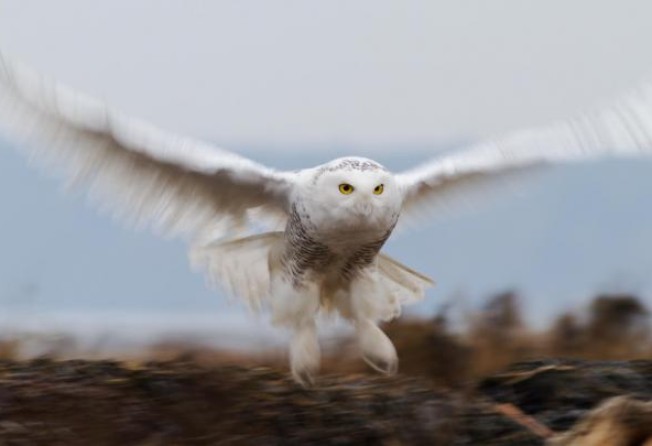Joy and concern as snowy owls arrive in Vancouver
Arctic raptors appearing in Vancouver a bird watchers’ delight, but a worry for experts puzzled by their unusual arrival in large numbers

Snowy owls, a symbol of the Arctic tundra, are flocking to the outskirts of temperate Vancouver, thrilling birdwatchers with their rare presence but worrying bird welfare experts.
More than two dozen of the magnificent white raptors have taken up residence on the foreshore of Boundary Bay, just south of the west Canadian city. The birds, listed as a threatened species in Canada since 1975, have attracted scores of birdwatchers who gather daily along a dyke at the edge of the foreshore.
The owls perch listlessly on logs and ground debris, alone or huddled in small groups, as photographers armed with long lenses snap away. Signs posted by the British Columbia Environment Department warn watchers not to get too close as the owls "need all their calories to survive winter".
It is the second winter in a row that Vancouver has been treated to a visit from snowy owls. But that is raising concern among experts who say the owls should normally only visit Vancouver every five or so years, a phenomenon linked to the population cycles of lemmings, a typical prey species, in the Arctic.
Rob Hope, the head bird care supervisor at the Orphaned Wildlife Rehabilitation Society (OWL), said their presence so far south was "more than likely to do with food or weather". Some snowy owls have recently ventured further afield, with sightings in the US state of Oregon, Hope said.
While their numbers have delighted many, their condition has been poor. Although it is disguised by their dense white feathers, some of the birds are badly emaciated.
Twelve distressed snowy owls have been handed over this winter to OWL, a bird rescue charity based in Delta, near Boundary Bay. Of those, nine were in such poor condition that they died.
Hope said that some were suffering from asperogillosis, a breathing problem caused by a fungus that can be triggered by a weakened immune system or malnutrition.
He said that some of the snowy owls had arrived in Boundary Bay at the start of November, earlier than they would normally venture so far south in search of prey as winter envelops the Arctic. That may indicate an early shortage of food to the north, perhaps linked to a population boom among owls there. Climate change has also been suggested as a cause.
Habitat destruction to the north was another possible factor in their arrival, said OWL founder Bev Day.
Whatever the case, their arrival in such large numbers at a relatively small habitat like Boundary Bay means that competition for prey species such as voles or small birds is fierce. And the owls already appear exhausted after their long journey south.
"We have been finding a lot in very poor condition by the time they arrive," Hope said. "They are already in a weakened state."
Hope said that while he could understand the excitement among birdwatchers, who have travelled from across North America to see the Boundary Bay owls, some were getting too close and stressing the animals.
"Eighty per cent of people are good and stay on the dyke. But some people chase the birds for that perfect shot, but that's energy that they can't waste. These birds should be conserving energy," he said.
Day, who founded OWL 37 years ago, said she was so upset about people getting too close and harassing the owls that she could not bring herself to go down to the nearby foreshore to observe them. Day told how one photographer had unleashed a pet poodle to chase an owl so that she could get a shot of it in flight.
Hope said that while the owls were periodic visitors to Boundary Bay, which has a hunting landscape that resembles the treeless tundra, they were ill-suited to extended visits in a region that is among the warmest and wettest in Canada. "They are coming from a cold, dry area to somewhere that is warm and wet. Their waterproofing is not great," he said. "They tend to be built [to maintain] warmth."
Facts about Harry Potter's friend
The ghostly white snowy owl is the largest of all owls, weighing up to 3kg or more with a wingspan that can stretch 1.5 metres. Their plumage makes them one of the most recognisable of their kind; adult males can be pure white, while females and juveniles have a black-scaled pattern. With their piercing yellow eyes, the birds’ distinctive appearance has made them a favourite of popular fiction; schoolboy wizard Harry Potter’s animal friend, Hedwig, was a snowy owl.
Although they only live about nine years in the wild, captive birds can live much longer.
Unusual among owls for hunting in both day and night, their preferred food in the Arctic is lemmings, a small rodent of the tundra prone to population booms and busts. Down cycles may help explain why snowy owls are occasionally forced far south of their normal range.
They have few natural predators, but often fall victim to human activity – in addition to the destruction of their native habitat, they are struck by planes and cars, are electrocuted by power lines and occasionally trapped deliberately.
Owls, including snowy owls, have been eaten as food or traditional medicine in parts of Asia.
Ian Young